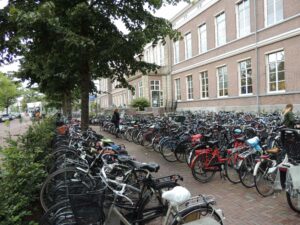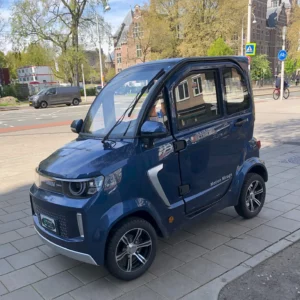….and it is in the Netherlands.
I recently holidayed there with my wife, Sandy, for a month – enough time to enjoy the Dutch way of life and see what we are missing.
Main purpose of the trip was to meet my new grandson, Raf, and catch up with his mum and dad. It didn’t hurt that I’m a cycling enthusiast and keen to learn how the Dutch have done it.
Bikes are everywhere and everyone’s on them. Kids cycling to school. Commuters to work. Grocery shopping. Utility trips of every sort (using a tow-trailer or purpose-built cargo bike). Weekdays it can mean carting littlies to school; weekends a run to the nursery for garden supplies.

My son Charlie and his partner Sarah (the dad and mum noted above) moved to a new apartment by bike. They live simply with minimal possessions. A few trips with a borrowed trailer – job done! (They have been in the Netherlands for seven years and have never owned a car).
They got married when we were there. It was a picture to see them ride off to the ceremony on their bikes – Charlie in his best attire, Sarah with dress flowing.
The common roadster, Omafiets in the Netherlands, is the around-town bike of choice. It’s low maintenance, sturdy for carrying loads, and allows a comfortable riding position.
Thirty-six percent of Dutch people list the bicycle as their most frequent way of getting around on a typical day. Half of primary age children ride a bike to school. Three-quarters of high school students do (84% for distances less than 5 km).
It wasn’t always this way. Road deaths, traffic congestion and rising fuel prices in the 1970s opened the Government to new ways of thinking. The 1980s brought a bike-lane building spree, forerunner to the safe-cycling network now serving the entire country.

But there’s more. Public transportation (subways, trams, buses) in the larger centres is efficient and affordable. Fast, punctual trains (100% fuelled by green energy) connect the main population centres.
Vehicle-sharing opportunities – minivans, cars, mopeds, cargo bikes – abound. EV options and recharging stations are plentiful. (All of the travel modes noted here help to lessen greenhouse gas emissions from the transport sector.)

Pedestrians are well served, too. On one main thoroughfare in Amsterdam, for example, I counted three crosswalks in a 400-metre stretch.
Contrast this with my own New Zealand small town: nearly 10 square kilometres in area and only seven crosswalks in total. The place is flat as a Dutch pancake – ideal for cycling – yet only recently have we seen an investment in cycling infrastructure. This thanks to the previous Labour Government with a vision of a less car-centric future – and generous funding for local councils to help make it happen.
The new Coalition Government – with their ‘roads, roads and more roads’ mantra – shares no such vision.
Hopefully this short-term thinking is just a bump in the road, and more enlightened leadership will return. When it does, let’s draw inspiration from the Dutch. They are showing us what’s possible.
Thank you to Gord Stewart for sharing this content with Ecodove.
Gord Stewart is a sustainability consultant based in New Zealand. He has a background in economics and environmental management. You can find more of Gord’s writing on his blog Taking the Long View: On sustainability and the environment.
Gord was born in Canada and spent the first half of his career working in health promotion. He moved to New Zealand in 2002 with his wife and two sons (teenagers then). Gord made a transition into the environment/sustainability area, aided by completing an MSc (with Distinction) in Environmental Management from Imperial College London (through their external programme/distance learning) in 2003. His consulting has since then been entirely in Sustainability and Environmental Management.